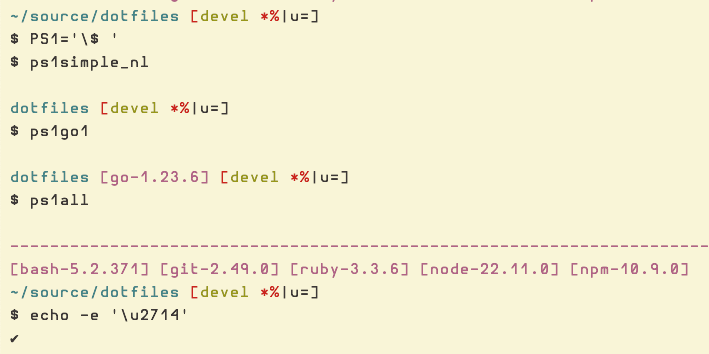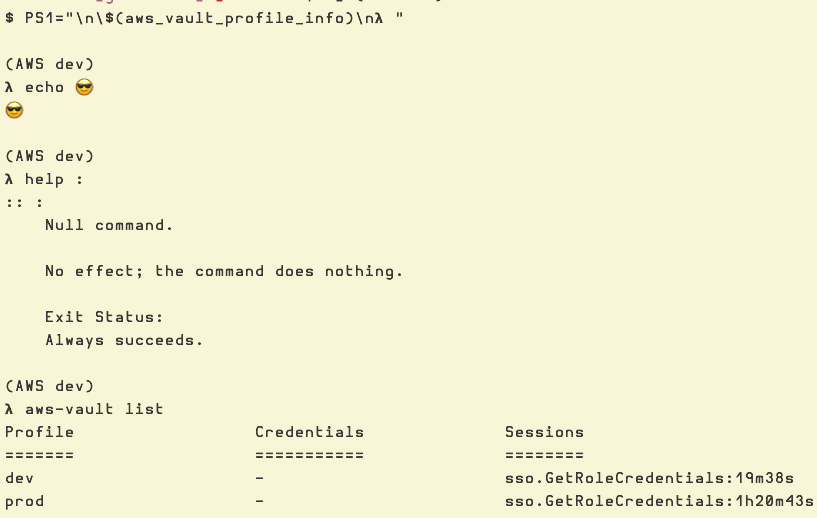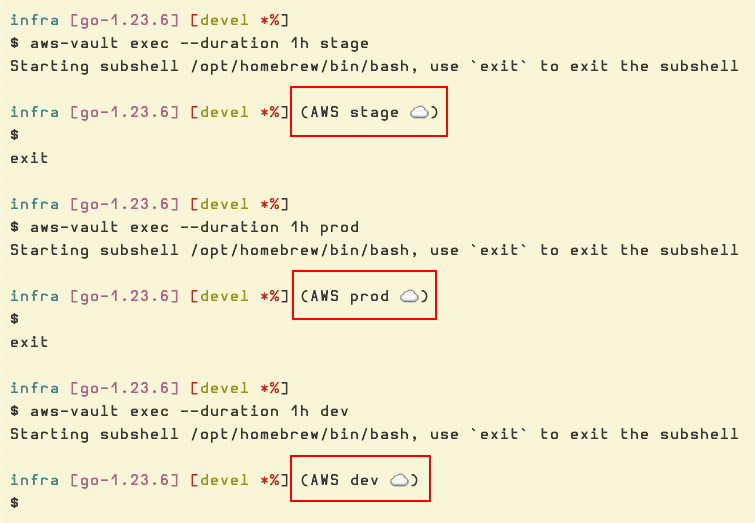Introduction¶
The onboarding documentation for one of the projects I joined some time ago suggested the following setup:
- Use ZSH as the default shell.
- Install oh-my-zsh which comes with many useful plugins, including displaying the current active AWS Vault profile in use.
- Add the alias alias
av='aws-vault exec --debug --duration=1h'to zsh’s config files so can simply typeav stageorav prodto login.
It works really well (zsh is amazing for interactive use, no denying that) and it shows the current active AWS profile in use for that shell session. In this screenshot, I’m using the Spaceship ZSH prompt with the lambda symbol “λ” (followed by a space) as the prompt character:

Yet, I still prefer to use Bash as my shell most of the time (and because it is the shell we use for almost 100% of shell scripts anyway).
Since my first steps in Unix-like systems (mostly Linux for me) I have always been infatuated with the idea of crafting bash prompts that would suit particular needs in different projects and situations. Maybe I’m working with Node.js, Ruby, Go, etc., and I want the prompt to show useful information depending on what I am doing at the moment. Check it out:

My prompt also shows a lot of Git information (new files, changed files, push/pull status, etc.), among other things I’m not covering or explaining in this post.
Anyway, how can we have Bash’s prompt to display aws-vault profile information?
Adding aws-vault profile info to bash’s prompt¶
It so happens that when we authenticate to one of the configured AWS Vault profiles, aws-vault fills in some environment variables for the subshell that gets created, as described in their readme:
For our purpose, we can make use of AWS_VAULT environment variable!
It works like this: if we log into the “dev” profile, that variable will contain the value “dev”.
Log into a profile like “stage” , and it will now contain the value “stage”, and so on and so forth for any other profiles.
$ PS1='\$ '
$ aws-vault exec --duration=1h dev
$ echo $AWS_VAULT
dev
$ exit
$ aws-vault exec --duration=1h stage
$ echo $AWS_VAULT
stageInspecting AWS_VAULT env var on bash
With that knowledge in mind, we can write a bash function similar to this one:
##
# Display aws-vault active profile session information.
#
# aws cli/vault sets the env var AWS_VAULT for the currently active
# profile session. Therefore, we just verify it is set with a
# non-empty value to decide if we display it in the prompt or not.
#
function aws_vault_profile_info () {
if [[ -z $AWS_VAULT ]]
then
return 0
fi
printf '(AWS %s)' "$AWS_VAULT"
}Bash function to display AWS Vault profile information
Then we test our newly created function as our PS1 bash prompt, maybe like this:
$ PS1="\n\$(aws_vault_profile_info)\n𝝺 "
(AWS dev) 𝝺 echo 😎
😎
(AWS dev) 𝝺Testing our new AWS Vault info function

Or write a shell function that can be later called without having to memorize any of the bash’s prompt syntax:
function ps1aws () {
PS1="\n\$(aws_vault_profile_info)\n𝝺 "
}Then simply call ps1aws function from a bash session (and log into some AWS Vault profiles, of course).
Adding an icon ☁️¶
If text-only is too dull for you, it is possible to include an icon to the prompt as well. Simply pick an icon from your favorite emoji picker, or use an hex escape sequence:

Or with the emoji copied from your emoji picker:
function aws_vault_profile_info () {
if [[ -z $AWS_VAULT ]]
then
return 0
fi
printf '(AWS %s ☁️)' "$AWS_VAULT"
# \
# \
# Add something like this.
}In any case, depending on which symbol or emoji we have chosen to include in our prompt, it could look like this:

Figure 1:AWS prompt with Nerd Font

Figure 2:AWS prompt with cloud emoji
Therefore, after the function is created, we can simply invoke it in the shell and from that moment on, any time we log into some AWS profile, the information will be displayed. And of course, it could be made permanent by adding it one of our bash config files.
In the end, it will look like this:

Figure 3:AWS Vault prompt in Bash
Cool 😎, huh‽
Conclusion¶
Check my dotfiles repo and my other bash prompt stuff if you want to see some more examples: